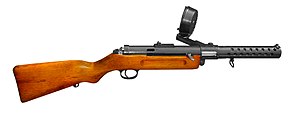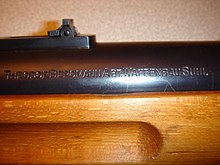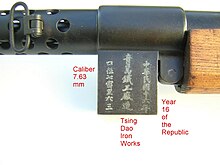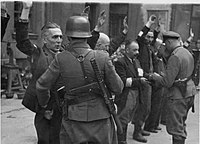MP 18
| MP 18 | |
|---|---|
 Bergmann MP 18 | |
| Type | Submachine gun |
| Place of origin | German Empire |
| Service history | |
| In service | 1918–1945 (Germany) |
| Used by | See Users |
| Wars | World War I German Revolution Irish Civil War Rif War Chaco War Spanish Civil War Second Sino-Japanese War Chinese Civil War German-Czechoslovak War World War II Malayan Emergency |
| Production history | |
| Designer | Hugo Schmeisser |
| Designed | 1916 1928 (MP 28/II) |
| Manufacturer | Bergmann Waffenfabrik Qingdao Iron Works SIG (SIG M1920) |
| Produced | 1918–1920s 1928-Early 1940s (MP 28/II) |
| No. built | Fewer than 30,000 |
| Specifications | |
| Mass | 4.18 kg (9.2 lb) 4.0 kg (8.8 lb) (MP 28/II) |
| Length | 832 mm (32.8 in) |
| Barrel length | 200 mm (7.9 in) |
| Cartridge | 9×19mm Parabellum 7.63×25mm Mauser (Export) 7.65×21mm Parabellum (Export) 9x23mm Largo (Export) (MP 28/II) 9x25mm Mauser (Export) (MP 28/II) .45 ACP (Export) (MP 28/II) |
| Action | open-bolt blowback |
| Rate of fire | ~350-500 round/min 550-600 round/min (MP 28/II) |
| Muzzle velocity | 380 m/s (1,247 ft/s) |
| Feed system | 20-round detachable box magazine (Prototypes, Post WW1, MP 28/II) 30-round detachable box magazine (Post WW1) 32-round detachable box magazine (MP 28/II) 32-round detachable TM 08 drum magazine (WW1) 50-round detachable box magazine (MP 28/II, from Lanchester); |
The MP 18 manufactured by Theodor Bergmann Abteilung Waffenbau was the first submachine gun used in combat. It was introduced into service in 1918 by the German Army during World War I as the primary weapon of the Sturmtruppen, assault groups specialized in trench combat. Although MP 18 production ended in the 1920s, its design formed the basis of most submachine guns manufactured between 1920 and 1960.[1]
History[]

What became known as the "submachine gun" had its genesis in the early 20th century and developed around the concepts of fire and movement and infiltration tactics, specifically for the task of clearing trenches of enemy soldiers, an environment within which engagements were unlikely to occur beyond a range of a few feet.
In 1915, the German Rifle Testing Commission at Spandau decided to develop a new weapon for trench warfare. An attempt to modify existing semi-automatic pistols, specifically the Luger and C96 Mauser failed, as accurate aimed fire in full automatic mode was impossible due to their light weight and high rate of fire of 1,200 rounds per minute. The Commission determined that a completely new kind of weapon was needed. Hugo Schmeisser, working for the Bergmann Waffenfabrik was part of a team composed of Theodor Bergmann and a few other technicians. They designed a new type of weapon to fulfill the requirements, which was designated the Maschinenpistole 18/I. It is not clear whether the 'I' stands for the number 1 or the letter I, although its successor, the MP28, was designated the Maschinenpistole 28/II (suggesting the former).
Full-scale production began in early 1918.[2] Though technically not the world's first submachine gun, being beaten by the double-barreled Italian Villar-Perosa of 1915, in modern usage of the term the MP 18 is considered the world's first submachine gun since the Villar Perosa had been designed to be used as a light machine gun on aircraft before it was adapted to infantry use as a single-barreled shoulder-fired weapon (the Beretta SMG) in late 1918.
Service history[]

The MP 18 served in the final stages of World War I in 1918, especially in the Kaiserschlacht offensive. More than 25,000 were produced, until the Treaty of Versailles banned production of military SMG in 1920.[3]
The MP 18 proved to be an excellent weapon. Its concept was well-proven in trench fighting. The basic design directly influenced later submachine gun designs and showed its superiority over the regular infantry rifle in urban, mobile, and guerrilla warfare. The MP 18 served with German police and paramilitary forces after the end of the war. It was widely used in combat by the Freikorps Von Epp against the Spartacus League in Bavaria and by other Freikorps in Berlin, where its efficiency in urban combat was demonstrated.
All the limited conflicts between 1920 and 1940 saw an increasing use of this new class of weapons, first in South America during the Chaco War,[4] then in Europe during the Spanish Civil War, and in China during the Warlord Era[5] and the Japanese invasion, where its use by well-trained Chinese troops was costly for the invaders as in the Battle of Shanghai.[citation needed] It was also used during World War II by various partisans and resistance forces.[1]

Since the treaty allowed the Weimar Republic to keep a small quantity of submachine guns for police use, a few hundred MP 18.1s were modified to accept Schmeisser's original 20-round magazine design. This modification, conducted by Haenel Waffenfabrik, required removal of the existing magazine well collar, and replacement with a different one. These weapons were overstamped with the date "1920" on the receiver and magazine well to show they were legitimate weapons owned by the Weimar Republic and not war bringbacks or clandestine weapons.[citation needed]
Bergmann sold the licence of the MP 18. 1 to SIG Switzerland; the Swiss made model was known as SIG Bergmann 1920. It existed in .30 Luger and 7.63 mm Mauser. The Bergmann MP 18.1 represents a milestone both in terms of armament technology and warfare tactics. It opened the way for a whole new class of weapons and triggered the research for lighter automatic firearms to be used by mobile troops. Its first direct competitors did not see service in World War I, but most of them saw use in all the limited conflicts taking place in the inter-war period.
Evolution[]

The French, despite being moderately interested by this class of armament because they had designed and introduced in service many semi-automatic and automatic weapons, immediately launched studies based on captured MP 18s. The design of the STA 1922 was adopted and the MAS 1924 or 9mm STA Modèle 1924 entered service and was used in colonial conflicts in Morocco. Around 1,000 were produced and these rifles, as well as ex-German captured MP 18,[1] saw limited service during World War II.[6]

The Chinese produced a modified MP 18 in Tsing Tao with the assistance of Heinrich Vollmer.[citation needed]


The MP 28 was produced by C. G. Haenel under the supervision of Hugo Schmeisser. The MP 28 was produced under license by Etablissements Pieper in Belgium.[7] It was copied by the Second Spanish Republic under the codename Naranjero. The Naranjero was chambered in 9mm Largo.[8]
The Austrian Steyr MP 34 was created by a team of technicians led by who designed a submachine gun for Rheinmetall in 1919 and used Bergmann's MG 15 to design the MG 30. The SIG Bergmann 1920 was used by Finland, Japan, and Estonia, it was the inspiration for the Estonian Tallinn 1923, the Japanese Type 100 submachine gun and the Finnish Suomi model 31, which in turn inspired Degtyarev for his PPD 34.
Emil Bergmann, Theodor Bergmann's son designed the MP 32 that evolved into the MP34 as adopted by Denmark before receiving the MP35 name when adopted by nascent Wehrmacht in 1935. This submachine gun is often mistaken with the Mitraillette 34, a MP28 made in Belgium by Pieper Bayard, former Bergmann licensed manufacturer or with the MP34 made by Steyr. It is easy to identify the Bergmann MP 32/34/35 or its final version 35/1 since the cocking lever works exactly like a rifle bolt.
In 1940, with a pressing need for individual automatic weapons, the British copied the MP 28 and developed the Lanchester submachine gun for the Royal Navy. Solidly built with the use of brass for the magazine well, and a bayonet mount, it entered service in 1940. The magazine and the bolt of the MP 28 could be used in the Lanchester. The British Sten used the side-mounted magazine configuration and a simplified version of the open-bolt firing operating system of the MP28.
The OVP 1918, an offspring of Revelli's Villar Perosa 1915, inspired[citation needed] Heinrich Vollmer for his telescopic bolt used in the VPM 1930, EMP, MP 38, MP 40 and MP 41. The MP 18 remained in limited service with the German armed forces during the Second World War, specifically with the Sicherheitsdienst, later eastern foreign divisions of the Waffen SS and also with Kriegsmarine coastal artillery units.
The Soviet Union made a similar use of MP 28 design in their PDD-34 sub machine gun in 1934. Further development of the PPD-34 led to the simplified PPD-40 and PPSh-41.[9]
Design details[]
The MP 18 was a heavy weapon, weighing over 5 kg (11.0 lb) when fully loaded. The receiver tube was very thick (~3 mm), compared with later World War II submachine guns with half that thickness or less, such as the Sten gun or MP 40.

Though Schmeisser designed a conventional 20-round-capacity "box" magazine for the weapon, the Testing Commission, for practical reasons, insisted that[citation needed] the MP 18 be adapted to use the 32-round TM 08 Luger "snail" drum magazine that was widely used with the long-barreled version of the Luger pistol.[1]

Like many other open-bolt designs, the MP 18 was prone to accidental discharge. If the buttstock of a loaded gun was given a hard knock while the bolt was fully forward, the gun could accidentally fire because of the bolt overcoming the action spring resistance and moving rearward enough to pick up a round, chamber it and fire. Soldiers liked to leave the bolt of their firearm in this closed or forward position, so dirt and debris would not enter the barrel and chamber. This 'Bolt-closure' practice acted as a dust cover for the weapon's chamber, preventing a malfunction from occurring because of the presence of foreign debris, but making accidental discharge more likely.

The German police asked for an external safety on their MP 18s, and a universal bolt-locking safety was added on all the submachine guns used by the police. Later submachine gun designs like the Sten and the MP 40 were modified to allow the cocking handle to be pushed inwards to lock the closed bolt to the tubular receiver casing. This design change prevented accidental discharges when the bolt was left forward and a loaded magazine was inserted.
Operation[]

The MP 18 submachine gun is a simple blowback operated weapon firing from the open bolt. The original MP 18.1 was designed to use the snail drum magazine of the Luger Artillery model pistol. This rotary design type of magazine holds 32 rounds of 9 mm Parabellum,[1] the user having to load the magazine with a proprietary loading tool. A special sleeve was required when the snail drum was used on the MP 18 to stop the snail drum from being inserted too far in the magazine well.
After 1920, the MP 18 was modified to use a straight magazine similar to those used in the later developed MP 40 submachine gun. The MP 18 could only fire in the fully automatic mode. Its successor, the MP 28/2, received a modified mechanism with a selector for single shot or fully automatic fire.
Users[]



 Belgium: MP-28 produced under license and adopted as MI-34 (Mitraillette Modèle 1934)[10]
Belgium: MP-28 produced under license and adopted as MI-34 (Mitraillette Modèle 1934)[10] Bolivia: MP-28[4]
Bolivia: MP-28[4] Canada: Some evidence that captured[citation needed] MP 18s in use with Alberta Provincial Police[11][12]
Canada: Some evidence that captured[citation needed] MP 18s in use with Alberta Provincial Police[11][12] Empire of Japan: Used Swiss-made SIG M/20 in 7.63×25mm Mauser[13] and used against the Chinese[14]
Empire of Japan: Used Swiss-made SIG M/20 in 7.63×25mm Mauser[13] and used against the Chinese[14] Finland: 1,523 SIG M/20s in 7.65×21mm Luger were bought between 1922 and 1940[13]
Finland: 1,523 SIG M/20s in 7.65×21mm Luger were bought between 1922 and 1940[13] France[1]
France[1] German Empire[1]
German Empire[1] Indonesia: ex-Japanese Swiss-made guns[15]
Indonesia: ex-Japanese Swiss-made guns[15] Malaya
Malaya China: Used locally made versions of the MP 18, MP 28[16] and Swiss-made SIG Bergmann 1920 in 7.63×25mm Mauser[13][17]
China: Used locally made versions of the MP 18, MP 28[16] and Swiss-made SIG Bergmann 1920 in 7.63×25mm Mauser[13][17] South Korea: Korean Liberation Army used in Second Sino-Japanese War received by National Revolutionary Army[citation needed]
South Korea: Korean Liberation Army used in Second Sino-Japanese War received by National Revolutionary Army[citation needed] Nazi Germany[1]
Nazi Germany[1] Norway: The Assault Group of the Norwegian Police Service acquired 26 SIG Bergmann 1920 submachine guns in 1937[18]
Norway: The Assault Group of the Norwegian Police Service acquired 26 SIG Bergmann 1920 submachine guns in 1937[18] Portugal: in 7.65mm[1]
Portugal: in 7.65mm[1] Romania: Large numbers of MP 28/II submachine guns were supplied to the Iron Guard by the Sicherheitsdienst,[19] used by the army after the Iron Guard Rebellion
Romania: Large numbers of MP 28/II submachine guns were supplied to the Iron Guard by the Sicherheitsdienst,[19] used by the army after the Iron Guard Rebellion Spanish State: MP 28s[20] produced under license[1]
Spanish State: MP 28s[20] produced under license[1] Slovak Republic (1939–1945): Used by Reinsurance division (Security division) in Belorussia and Ukraine against pro-Soviet partisans
Slovak Republic (1939–1945): Used by Reinsurance division (Security division) in Belorussia and Ukraine against pro-Soviet partisans Weimar Republic: Used by the police after WWI.[21]
Weimar Republic: Used by the police after WWI.[21]
Notes[]
- ^ Jump up to: a b c d e f g h i j Bishop, Chris, ed. (1998). "MP 18 and MP28". The Encyclopedia of Weapons of World War II. Orbis publishing. p. 258. ISBN 1586637622.
- ^ "Historic Firearm of the Month, July 2000: Maschinenpistole 18, I". Cruffler.com.
- ^ de Quesada 2014, p. 9.
- ^ Jump up to: a b de Quesada, Alejandro (20 November 2011). The Chaco War 1932-35: South America's greatest modern conflict. Men-at-Arms 474. Osprey Publishing. p. 24. ISBN 978-1-84908-901-2.
- ^ Jowett, Philip (15 Jul 1997). Chinese Civil War Armies 1911–49. Men-at-Arms 306. Osprey Publishing. p. 43. ISBN 9781855326651.
- ^ "Le pistolet mitrailleur de 9 mm STA modèle 1924". armesfrancaises.free.fr (in French).
- ^ de Quesada 2014, p. 10.
- ^ "Naranjero" (in Spanish). Armia - Museo de la Industria Armera. Archived from the original on 2011-07-23.
- ^ McNab, Chris (20 May 2014). Soviet Submachine Guns of World War II: PPD-40, PPSh-41 and PPS. Weapon 33. Osprey Publishing. pp. 8–9. ISBN 9781782007944.
- ^ de Quesada 2014, p. 11.
- ^ "Let Justice Be Done: The Alberta Provincial Police, 1917-1932". Provincial Archives of Alberta. Retrieved 2020-08-22. "Image". Retrieved 2020-08-22.[better source needed]
- ^ "Weapons". The Alberta Provincial Police. Retrieved 2020-08-22.
- ^ Jump up to: a b c Thompson, Leroy (23 Mar 2017). The Suomi Submachine Gun. Weapon 54. Osprey Publishing. p. 8. ISBN 9781472819642.
- ^ Lai, Benjamin (29 Jun 2017). Shanghai and Nanjing 1937: Massacre on the Yangtze. Campaign 309. Osprey Publishing. p. 21. ISBN 9781472817495.
- ^ Bloomfield, Lincoln P.; Leiss, Amelia Catherine (30 June 1967). The Control of local conflict: a design study on arms control and limited war in the developing areas. 2. Massachusetts Institute of Technology. Center for International Studies. p. 149. hdl:1721.1/85055.
- ^ Jowett, Philip S. (2005). The Chinese Army 1937–49: World War II and Civil War. Osprey Publishing. p. 42. ISBN 978-1841769042.
- ^ Shih, Bin (2018). China's Small Arms of the Second Sino-Japanese War (1937-1945).
- ^ Magnar Skaret (2017). Politiets Våpen. Norsk Politihistorisk Selskap. p. 143-145. ISBN 978-82-998108-4-5.
- ^ Mark Axworthy (1992). The Romanian Army of World War II. Osprey Publishing. p. 46. ISBN 1855321696.
- ^ de Quesada, Alejandro (20 May 2014b). The Spanish Civil War 1936–39 (1): Nationalist Forces. Men-at-Arms 495. Osprey Publishing. p. 38. ISBN 9781782007821.
- ^ Willbanks, James H. (2004). Machine Guns: An Illustrated History of Their Impact. ABC CLIO. p. 80. ISBN 978-1851094806.
Bibliography[]
- de Quesada, Alejandro (2014). MP 38 and MP 40 Submachine Guns. Weapons 31. Osprey Publishing. ISBN 978-1780963884.
Further reading[]
- Clinton Ezell, Edward. Small arms of the world, Eleventh Edition, Arms & Armour Press, London, 1977
- Cornish, Paul (2009). Machine Guns and the Great War. Pen & Sword Books Limited. ISBN 978-1848840478.
- de Vries, G.; Martens, B.J. The MP 38, 40, 40/1 and 41 Submachine gun, Propaganda Photos Series, Volume 2, Special Interest Publicaties BV, Arnhem, The Netherlands. First Edition 2001
- Gotz, Hans Dieter, German Military Rifles and Machine Pistols, 1871–1945, Schiffer Publishing, Ltd. West Chester, Pennsylvania, 1990. OCLC 24416255
- Günter Wollert; Reiner Lidschun; Wilfried Kopenhagen, Illustrierte Enzyklopädie der Schützenwaffen aus aller Welt: Schützenwaffen heute (1945-1985), Berlin : Militärverlag der Deutschen Demokratischen Republik, 1988. OCLC 19630248
- Smith, W.H.B, Small arms of the world: the basic manual of military small arms, Harrisburg, Pa.: Stackpole Books, 1955. OCLC 3773343
External links[]
| Wikimedia Commons has media related to MP18. |
- 1918 establishments in Germany
- 1920s disestablishments in Germany
- 7.63×25mm Mauser submachine guns
- 7.65×21mm Parabellum submachine guns
- 9mm Parabellum submachine guns
- Firearms by Hugo Schmeisser
- Simple blowback firearms
- Submachine guns of Germany
- Weapons and ammunition introduced in 1918
- World War I German infantry weapons
- Weapons of the Ottoman Empire
- World War I submachine guns
- World War II infantry weapons of China
- World War II infantry weapons of Germany
- World War II submachine guns